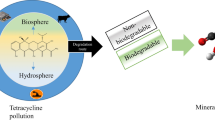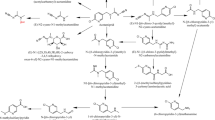Abstract
Endosulfan is one of the few organochlorine insecticides still in use in China for protecting crops from a variety of insects. Endosulfan is toxic in fishes and rodents in the in vivo assays, but its genotoxicity in mammalian cells has not been well tested. In this work, a genotoxic testing system has been developed based on the induction of a HepG2/GADD153-GFP reporter gene expression in response to the DNA-damaging agents. Methyl methanesulfonate, a known carcinogenic and genotoxic agent, was used to test the effects of damage dose and post-treatment incubation time on GADD153-GFP expression. Subsequently, the system was applied to the genotoxicity evaluation of endosulfan. Endosulfan was able to cause the increase of GADD153-GFP expression at a sublethal dose (0.02–20 mg/L). In particular, it induced a maximum green fluorescent protein expression at the tested concentration of 0.2 mg/L, with 4.07-fold inflorescence relative to untreated cells. The results suggest that endosulfan has the potential genotoxicity for HepG2 cell line by inducing DNA damage. The study also confirms that the induced GADD153-GFP expression system is an appropriate and sensitive method for the assessment of genotoxicity from a broad range of pesticides with the DNA-damaging potential.
Similar content being viewed by others
References
Aggarwal, M., Naraharisetti, S. B., Tiwari, A. K., Degen, G. H., & Malik, J. K. (2008). Assessment of apoptosis in peripheral blood lymphocytes and splenocytes of chickens simultaneously exposed to arsenite in drinking water and endosulfan in feed. Toxicology Letters, 180(Suppl. 1), 208.
Ames, B., & Gold, L. S. (1997). Environmental pollution, pesticides, and the prevention of cancer: Misconceptions. FASEB Journal, 11, 1041–1052.
Balasubramani, A., & Pandian, T. J. (2008). Endosulfan suppresses growth and reproduction in zebrafish. Current Science, 94, 883–890.
Banu, B. S., Danadevi, K., Rahman, M. F., Ahujia, Y. R., & Kaiser, J. (2001). Genotoxic effect of monocrotophos to sentinel species using comet assay. Food Chemical Toxicology, 39, 361–366.
Barbosa, A., Rosinova, E., Dempsey, J., & Bonin, A. M. (1994). Determination of genotoxic and other effects in mice following short term repeated dose and subchronic inhalation exposure to phosphine. Environmental Molecular Mutagen, 24, 81–88.
Bolognesi, C. (2003). Genotoxicity of pesticides: A review of human biomonitoring studies. Mutation Research, 543, 251–272.
Borenfreund, E., & Puerner, J. A. (1985). A simple quantitative procedure using monolayer cultures for cytotoxicity assays (FTD/NR-90). Methods Cell Science, 9, 7–9.
Dutta, H. M., & Dalal, R. (2008). The effect of endosulfan on the ovary of bluegill sunfish (Lepomis macrochirus): A histopathological study. International Journal of Environmental Research, 2, 215–224.
Fransson-Steen, R., Flodstrom, S., & Warngard, L. (1992). The insecticide endosulfan and its two stereoisomers promote the growth of altered hepatic foci in rats. Carcinogenesis, 13, 2299–2303.
Giri, S., Prasad, S. B., Giri, A., & Sharma, G. D. (2002). Genotoxic effects of malathion: An organosphorus insecticide, using three mammalian bioassays in vivo. Mutation Research, 514, 223–231.
Gupta, A. K., Pandey, P., & Srivastava, S. (2007). Effect of pesticides on the enzyme activity in the fish, Channa striatus. Plant Archives, 7, 749–751.
Hu, G., Xu, M., & Dai, J. (2007). Progress in the study of toxicological effects of endosulfan on aquatic organisms. Journal of Fishery Sciences of China, 14(6), 1042–1047.
Jergentz, S., Mugni, H., Bonetto, C., & Schulz, R. (2004). Runoff-related endosulfan contamination and aquatic macroinvertebrate response in rural basins near Buenos Aires, Argentina. Archives of Environmental Contamination and Toxicology, 46, 345–352.
Jia, Z. Q., & Misra, H. P. (2007). Exposure to mixtures of endosulfan and zineb induces apoptotic and necrotic cell death in SH-SY5Y neuroblastoma cells in vitro. Journal of Applied Toxicology, 27, 434–446.
Kumar, S. N., Jain, A. K., Singh, K. P., Shrivastava, N., & Telang, A. G. (2008). Sub-acute toxic effect of ochratoxin A and endosulfan alone and their combination on hormonal disorder in adult male rats. Toxicology Letters, 180(Suppl. 1), 188.
Lee, G. S., Blonsky, K. S., Lee, D. V., Savage, E. A., Morgan, A. R., & von Borstel, R. C. (1992). Base alterations in yeast induced by alkylating agent with different Swain–Scott substrate constants. Journal of Molecular Biology, 223, 617–626.
Li, N. (2007). EU withdrawal endosulfan and the effect on Chinese tea export. Agrochemicals, 46(6), 428–430.
Lu, Y., Morimoto, K., Takeshita, T., Takeuchi, T., & Saito, T. (2000). Genotoxic effects of α-endosulfan and β-endosulfan on human HepG2 cells. Environmental Health Perspective, 108, 559–561.
Luethy, J. D., & Holbrook, N. J. (1992). Activation of the gadd153 promoter by genotoxic agents: A rapid and specific response to DNA damage. Cancer Research, 52, 5–10.
Price, B. D., & Galderwood, S. K. (1992). Gadd45 and Gadd153 messenger RNA levels are increased during hypoxia and after exposure of cells to agents which elevate the levels of the glucose-regulated proteins. Cancer Research, 52, 3814–3817.
Quillardet, P., Huisman, O., & Hofnung, M. (1982). SOS chromotest, a direct assay of an SOS function in Escherichia coli K12 to measure genotoxicity. Proceedings of the National Academy of Sciences of USA-Biological Sciences, 79, 5971–5975.
Sambrook, J., Fritsch, E. F., & Maniatis, T. (1989). Molecular cloning (pp. 852–897). New York: Cold Spring Harbor.
Silva, M. H., & Gee, J. (2008). Endosulfan: An evaluation of neurotoxicity, genotoxicity, oncogenicity and endocrine disruption. Birth Defects Research Part A-Clinical and Molecular Teratology, 82, 378–380.
Sohn, H. Y., Kwon, C. S., Kwon, G. S., Lee, J. B., & Kim, E. (2004). Induction of oxidative stress by endosulfan and protective effect of lipid-soluble antioxidants against endosulfan-induced oxidative damage. Toxicology Letters, 151, 357–365.
Steenland, K., Carrano, A., Ratcliffe, J., Clapp, D., Ashworth, L., & Meinhardt, T. (1986). A cytogenetic study of papaya workers exposed to ethylene dibromide. Mutation Research, 170, 151–160.
Thompson, K. L., & Sistare, F. D. (2003). Selection of drugs to test the specificity of the TG.AC assay by screening for induction of the gadd153 promoter in vitro. Toxicological Sciences, 74, 260–270.
Yang, T. T., Cheng, L., & Kain, S. R. (1996). Optimized codon usage and chromophore mutations provide enhanced sensitivity with the green fluorescent protein. Nucleic Acids Research, 24, 4592–4593.
Author information
Authors and Affiliations
Corresponding author
Rights and permissions
About this article
Cite this article
Li, D., Liu, J. & Li, J. Genotoxic evaluation of the insecticide endosulfan based on the induced GADD153-GFP reporter gene expression. Environ Monit Assess 176, 251–258 (2011). https://doi.org/10.1007/s10661-010-1580-7
Received:
Accepted:
Published:
Issue Date:
DOI: https://doi.org/10.1007/s10661-010-1580-7




